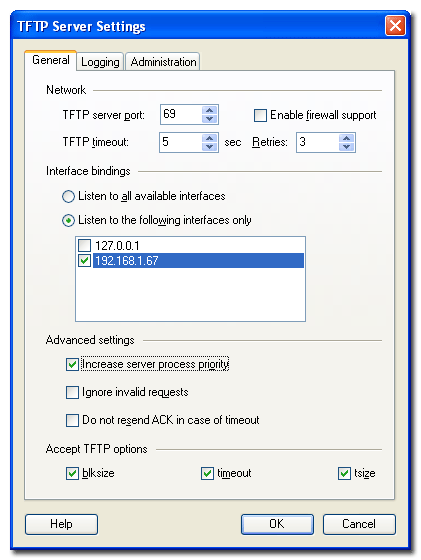

- #LOAD TFTPSERVER ... INSTALL#
- #LOAD TFTPSERVER ... DOWNLOAD#
- #LOAD TFTPSERVER ... MAC#
- #LOAD TFTPSERVER ... WINDOWS#
In the event that you want to use the utility for development purposes, then it is recommended you have Visual Studio 2010 or a newer version installed. Unlimited and simultaneous transfers are permitted.
#LOAD TFTPSERVER ... WINDOWS#
A handy tool for managing TFTP server implementationīy default, it runs as a Windows service and offers support for IPv4 and IPv6 protocols, in addition to blocksize, windowed mode for high-speed downloads, and single port mode to make sure that only port 69 will be used. Log details are auto-recorded to the Windows Event Log and may be investigated from this app's panel, while additional history can be obtained for an extra hour or day. The servers can be started and stopped from the main window. You will be happy to learn that you can add as many servers as you want to easily manage their properties. You can get started by accessing the Configure button and adding the server by specifying details such as the name, address, ports, timeout, window size, root path and TTL.įrom the server setting window, you can configure the behavior as well, in the sense that you can specify whether to allow reads and writes, automatically create subdirectories, convert path separators “/” or “\”, enable single port mode, as well as disable packet fragmentation. The interface consists of a single window interface that includes all the options. The setup is a quick and uneventful operation that does not need any special attention on your part. Allows you to manage multiple servers simultaneously You may have used it if you’ve ever remotely booted a machine with PXE or BOOTP.TFTP Server is a simple and straightforward utility that provides you with a dedicated tool for implementing modifications to the TFTP servers.
#LOAD TFTPSERVER ... DOWNLOAD#
This handy and lightweight server is useful to upload and download files, but it comes with some important limitations that you have to keep in mind.

The file “hello_client.txt” exists on the server but it’s not publicly writable.The “-create” option is not enabled on the server (see above).

The file “hello_client.txt” doesn’t exist on the servers “/srv/tftp” directory.If you get the following error when uploading: tftp> put hello_client.txt On the client side, I can upload a file with the following commands: $ tftp On the client side I start an interactive session and I download it as follows: $ tftp I created the following text file in “/srv/tftp”: After you edit “/etc/default/tftpd-hpa”, restart the tftp server with “service tftpd-hpa restart”. If you want to allow clients to upload new files in “/srv/tftp” then you need to add the “-create” option like this: TFTP_OPTIONS=”-secure – -create”. In addition, files can be uploaded in “/srv/tftp” only if they already exist in that directory and are publicly writable. The “-secure” option adds security to TFTP by limiting all transactions in the TFTP_DIRECTORY. To change that, you must edit the following configuration file: $ cat /etc/default/tftpd-hpa tftpd-hpa uses the directory “/srv/tftp” for uploading and downloading.
#LOAD TFTPSERVER ... INSTALL#
Once you install the server, it will start running as a daemon and ready to receive and send files.
#LOAD TFTPSERVER ... MAC#
If you are on Windows or MAC OS, you can find online TFTP clients or servers for your machine. You can install the server with: $ apt-get install tftpd-hpa This may give a long list, but you can easily identify the ones that are actual TFTP packages. Tftpd - Trivial file transfer protocol server Tftp - Trivial file transfer protocol client You can search Debian repositories for TFTP packages by using the following command: $ apt-cache search tftp There are a few implementations of this command. Think about it as the ‘telnet’ of remote access protocols. More importantly it’s INSECURE! All data is transferred unencrypted over UDP, so don’t use it to transfer any sensitive information or receive date from unverifiable sources.īy1981 network standards, this wasn’t so much of a concern that’s why today, this command is mostly used in LANs where you have control over all of the parameters that could compromise security. This command is not able to list, delete, or rename files like more advanced FTP services can do. Its simplicity comes with some serious tradeoffs. For that reason it has found extensive usage in many applications, such as the network booting protocols PXE and BOOTP. The goal of the designers was to build an FTP that is small in size and memory footprint, yet easy to implement. TheTrivial File Transfer Protocol (TFTP) was standardized in 1981, according to the RFC 1350.


 0 kommentar(er)
0 kommentar(er)
